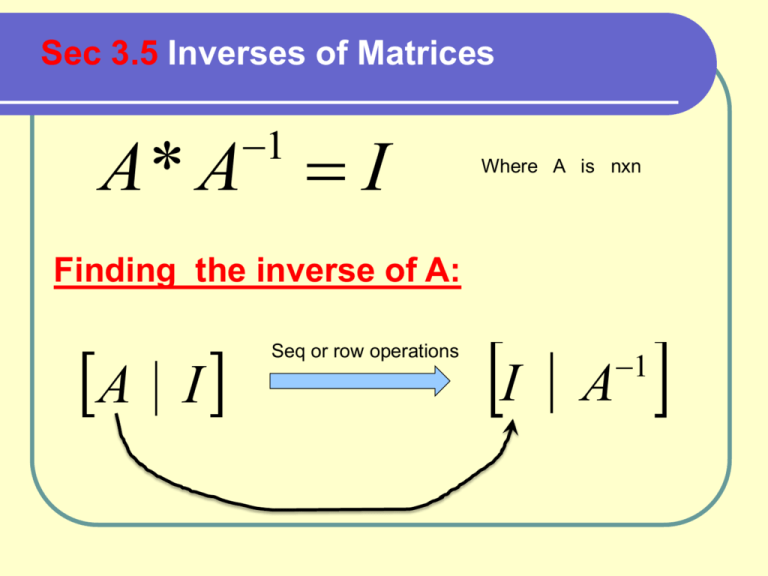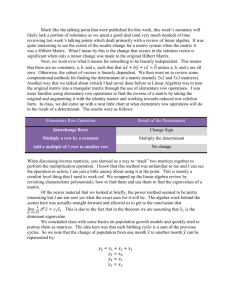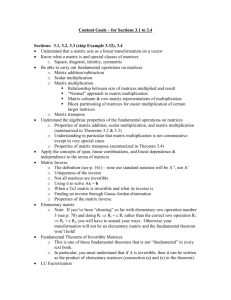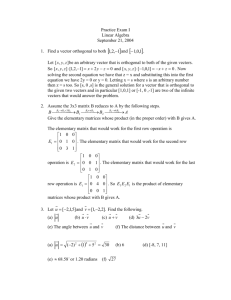Sec 3.5
advertisement

Sec 3.5 Inverses of Matrices 1 A* A I Where A is nxn Finding the inverse of A: A I Seq or row operations I A 1 Finding the inverse of A: A * * * 1 0 0 * * * 0 1 0 * * * 0 0 1 1 * * * * * * * * * * * * * * * * * 1 * * * * * 0 * * * * * 0 * * * * * 1 * * * * * 0 1 * * * * 0 0 1 * * * 1 * * * * * 0 1 * * * * 0 0 * * * * 1 * * * * * 0 1 * * * * 0 * * * * * 1 * 0 * * * 0 1 0 * * * 0 0 1 * * * 1 0 0 * * * 0 1 0 * * * 0 0 1 * * * Example Find inverse A 1 1 1 5 A 1 4 13 3 2 12 Properties 1) A B B A 2) A ( B C ) ( A B) C 3) A( BC ) ( AB)C 4) A( B C ) AB AC 5) ( A B)C AC BC Fact1: AB in terms of columns of B B [b1 , b2 ,, bn ] AB [ Ab1 , Ab2 ,, Abn ] Fact1: Ax in terms of columns of A x [ x1 , x2 ,, xn ] T Ax x1a1 x2 a2 x2 an Basic unit vector: 1 0 e1 , 0 0 1 e2 , 0 Ae j ???? AI ???? 0 e j 1 0 J-th location Def: A is invertable if There exists a matrix B such that AB BA I TH1: the invers is unique TH2: the invers of 2x2 matrix 1 d b A det c a det ad bc a b A c d Example Find inverse 4 6 A 5 9 TH3: Algebra of inverse If A and B are invertible, then 1 A1 is invertable and ( A1 )-1 A 2 n 0, An is invertible and ( An ) 1 ( A1 ) n 3 4 ( AB) 1 B 1 A1 ( ABCD) 1 D 1C 1B 1 A1 TH4: solution of Ax = b A is nxn invertible matrix and b is a n - vector Ax b has a uique sol x A1b Example 4x 6 y 6 5 x 9 y 18 Solve Def: E is elementary matrix if 1) Square matrix nxn 2) Obtained from I by a single row operation 1 0 I 0 1 1 0 0 I 0 1 0 0 0 1 R1 R2 2 R1 R3 0 1 E1 1 0 1 0 0 E2 0 1 0 2 0 1 Which of these matrices are elementary matrices 5 1 E1 1 0 1 0 E5 0 0 0 0 0 1 0 0 0 1 1 0 0 1 1 2 0 E2 0 1 0 0 0 1 1 1 E5 0 0 0 0 0 1 0 0 0 1 0 0 1 1 1 2 0 E3 0 0 1 0 1 0 0 0 E4 0 1 0 0 1 1 0 0 0 1 0 0 0 0 REMARK: Let E corresponds to a certain elem row operation. It turns out that if we perform this same operation on matrix A , we get the product matrix EA 2 R1 R3 1 0 0 I 0 1 0 0 0 1 1 1 2 A 3 1 4 2 0 1 2 R1 R3 1 1 2 A2 0 2 5 3 1 4 ?? ?? R2 R3 1 0 0 E2 0 0 1 0 1 0 1 0 0 E1 0 1 0 2 0 1 1 1 2 A1 3 1 4 0 2 5 1 1 2 A1 3 1 4 0 2 5 A1 E1 A NOTE: 1 0 0 I 0 1 0 0 0 1 E11 Every elementary matrix is invertible R1 R3 ?? 1 0 0 I 0 1 0 0 0 1 1 E3 0 0 1 E1 0 1 0 1 0 0 ?? 0 0 1 E11 0 1 0 1 0 0 1 0 0 I 0 1 0 0 0 1 E21 ?? TypeI 1 0 0 A1 0 1 0 2 0 1 2 R1 R3 1 0 0 E3 0 1 0 2 0 1 1 E21 0 0 I Eˆ 3 E3 0 1 5 0 0 0 1 5R2 2 R1 R3 1 0 0 Eˆ 3 0 1 0 2 0 1 1 0 0 E31 0 1 0 2 0 1 1 0 0 E2 0 5 0 0 0 1 TypeII 1 0 0 I 0 1 0 0 0 1 TypeIII Any observation?? Sec 3.5 Inverses of Matrices TH6: A A identity matrix I is invertible A I Row operation 1 A1 A1 E1 A Row operation 2 * A2 * Row operation 3 Row operation k Ak 1 Ek 1 Ak 2 A2 E2 A1 I Ek Ek 1 E2 E1 A 1 A Ek Ek 1 E2 E1 A Ek Ek 1 E2 E1 1 A is row equivalent to 1 1 1 1 E1 E2 Ek 1Ek I A1 I Ek Ak 1 Note : the sequence of elementary row operations that tran sform A into I also transforms I into A -1 A is invertable A is a product of elementary matrices Solving linear system Example Solve 4x 3y 2z 2 5 x 6 y 3z 1 3x 5 y 2 z 4 4 3 2 x 2 5 6 3 y 1 3 5 2 z 4 x 2 14 3 4 3 y A1 1 8 1 A 1 2 2 z 4 39 7 11 9 Example Solve 4x 3y 2z 0 5 x 6 y 3z 0 3x 5 y 2 z 0 4 3 2 x 0 5 6 3 y 0 3 5 2 z 0 What is the solution Quiz2: SAT in Class (3.3+3.4) 1) Given a matrix A find the reduced row echelon form 2 1 2 0 A 1 1 0 0 3 1 1 0 2) Use the method of Gauss-Jordan elimination to solve the following system (find the solution in vector form (i.e) as a linear combination of vectors) 1 9 0 0 0 0 0 1 0 0 0 0 0 1 0 Quiz3: Sund online (3.3+3.4) Matrix Equation In certain applications, one need to solve a system Ax = b of n equations in n unknowns several times but with different vectors b1, b2,.. Ax1 b1 Example 4 3 2 A 5 6 3 3 5 2 Ax2 b2 Axk bk Solve AX B 3 1 2 6 B 7 4 1 5 5 2 4 1 3 4 3 A1 1 2 2 7 11 9 1 XA B Ax1 Ax1 Ax2 Axk b1 x2 xk b1 AX B b2 bk b2 bk Matrix Equation Definition: A is nonsingular matrix if the trivial solution Example Show that A is nonsingular 1 1 0 A 0 1 0 1 0 1 the system Ax 0 has only x0 RECALL: Definitions invertible nonsingular Row equivalent Theorem7:(p193) A row equivalent I Every n-vector b Ax = b has unique sol A Invertible A is a product of elementary matrices Every n-vector b Ax = b is consistent The system Ax = 0 has only the trivial sol A nonsingular TH7: A is an nxn matrix. The following is equivalent (a) A is invertible (b) A is row equivalent to the nxn identity matrix I (c) Ax = 0 has the trivial solution (d) For every n-vector b, the system A x = b has a unique solution (e) For every n-vector b, the system A x = b is consistent Problems (page194) 34) Show that a diagonal matrix is inverible if and only if each diagonal element is nonzero. In this case , state concisely how the invers matrix is obtained. 35) Let A be an nxn matrix with either a row or a column consisting only of zeros. Show that A is not invertible. 41) Show that the i-th row of the product AB where Ai is the i-th row of the matrix A. is Ai B, ? ? ? ? ? ? True & False A row equivalent I Every n-vector b Ax = b has unique sol A not Invertible A is a product of elementary matrices Every n-vector b Ax = b is consistent The system Ax = 0 has only the trivial sol A nonsingular







